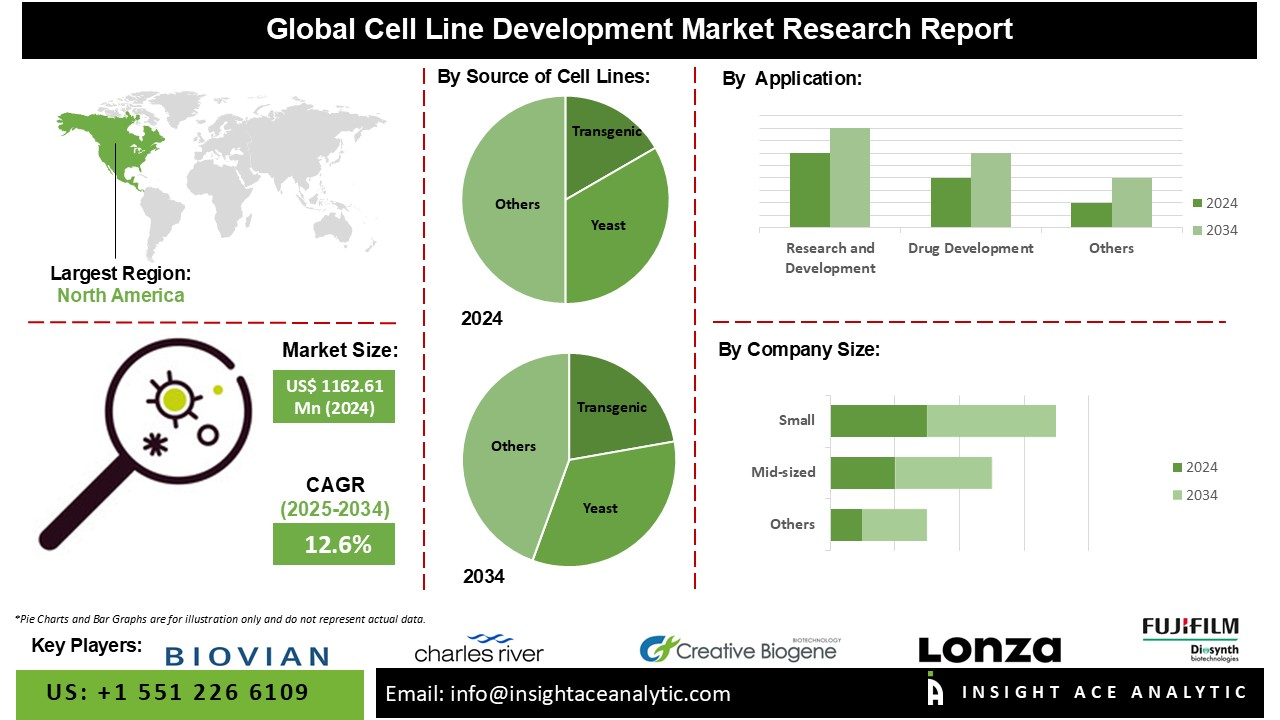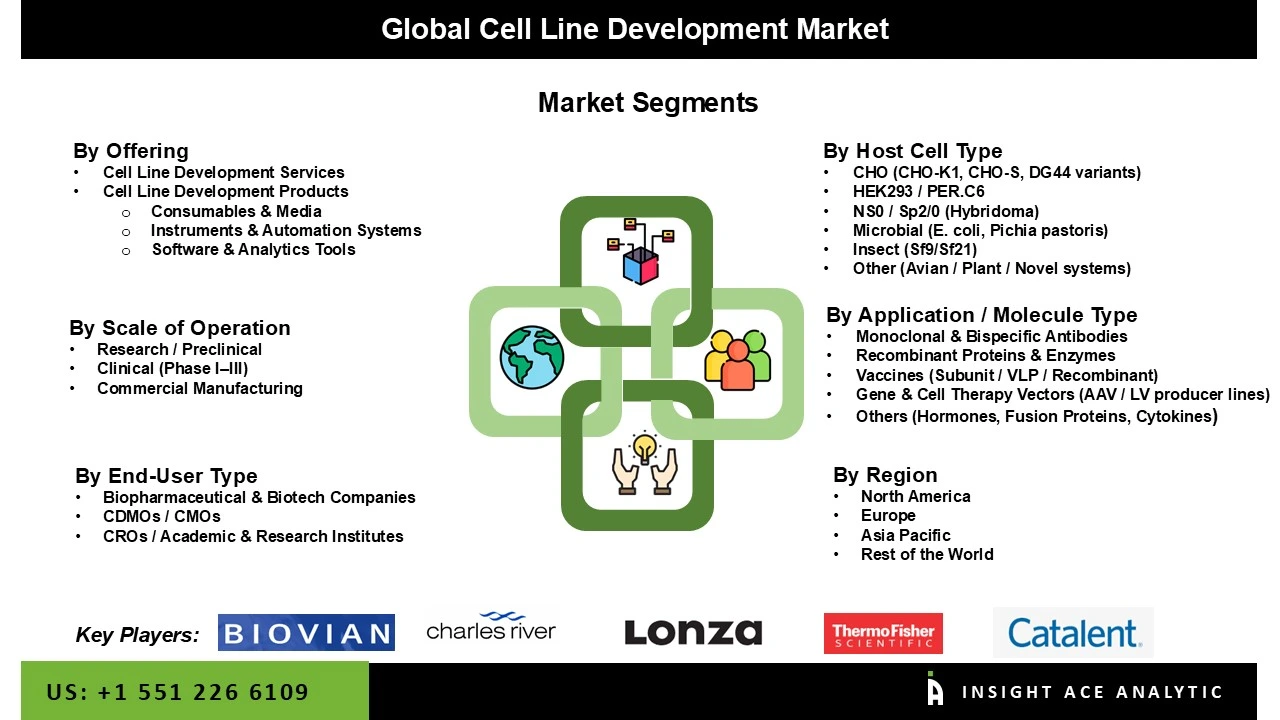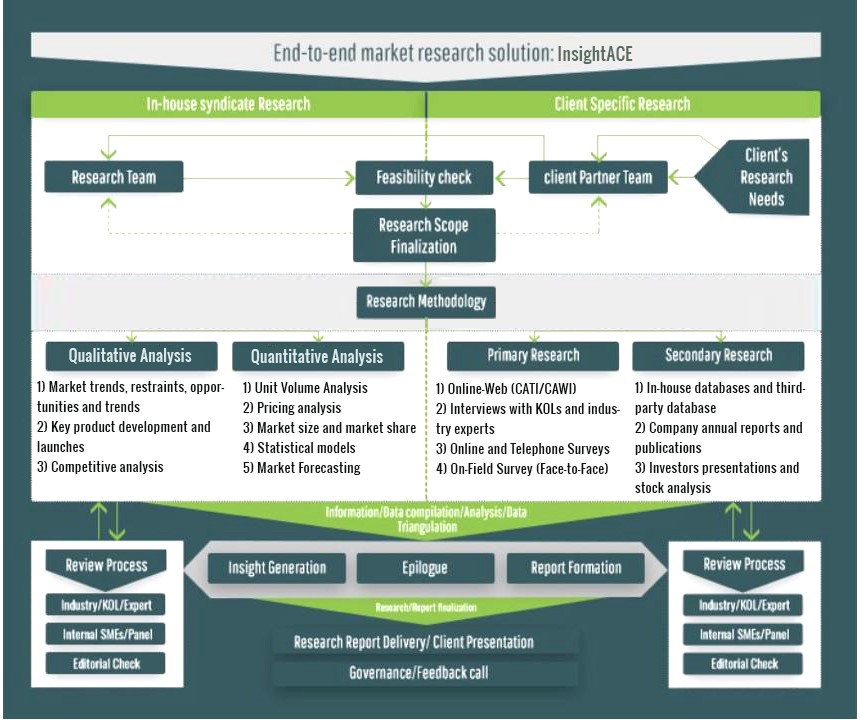Global Cell Line Development Market Size is valued at USD 1162.61 Mn in 2024 and is predicted to reach USD 3790.05 Mn by the year 2034 at a 12.6% CAGR during the forecast period for 2025-2034.
Cell line development creates highly productive, stable cell lines required for bio-therapeutic production and manufacture. These single-celled organisms create vaccines, monoclonal antibodies, and fusion proteins. Thousands of clones are screened during the development phase to locate those producing a significant volume of bi-product while also exhibiting essential quality traits.

The features of cell lines make them more useful in synthesizing biological medicinal compounds. This raises the requirement for cell line development. As the biopharmaceutical sector grows, the cell line development (CLD) procedure is projected to be in high demand. The availability of improved methods for producing novel cell lines and an increase in demand for monoclonal antibodies and cancer medicines are expected to fuel market growth in the future years.
However, the supply chains for cell culture reagents, medium, equipment, and other vital components required in cell line creation have been hampered by worldwide lockdowns, travel restrictions, and interruptions in transportation and logistics. Many companies and research organizations have experienced delays, shortages, and cost increases as a result of these factors.
The Cell Line Development Market is segmented on the basis of source, application, company size and biologics type. As per the source, the market is segmented asTransgenic, Yeast, Bacteria, Mammalian Cells. The application segment includes Research and Development and Drug Development. By company size, the market is segmented into Very Large and Large, Mid-sized, and Small. By Biologics Type, the segment comprises Recombinant Proteins and Others
The mammalian category is expected to hold a major share in the global Cell Line Development Market in 2024. The selection of cell line sources is necessary to develop economically viable, stable cell lines. Because of their higher complex protein expression capabilities, mammalian cell lines are most commonly used to manufacture monoclonal antibodies, vaccines, and biologics. Mammalian cell culture techniques are being explored to provide vaccines for diseases such as mumps, rubella, and measles in humans, as well as foot and mouth disease in veterinary medicine. It is the fastest-growing market due to the effective manufacture of biopharmaceuticals by mammalian cell lines, which can produce complex proteins in a manner similar to humans. This is predicted to enhance mammalian cell line source revenue share in the CLD market.
The drug development segment is estimated to grow rapidly in the global Cell Line Development Market. This is attributed to increased demand for pharmaceuticals and vaccine manufacture. Bio-production technology includes the development of biologics-based therapy medications such as vaccines, therapeutic proteins, cell treatments, and gene therapies. The most prevalent applications of bio-production are biologics and vaccines, and demand is expected to rise considerably in the future due to an increase in viral and infectious diseases, particularly in poor countries.
The North America Cell Line Development Market is expected to register the highest market share in revenue in the near future. This can be attributed to the benefits connected with cell culture techniques, such as cost-effectiveness and high productivity; cell culture techniques are becoming more popular. Factors contributing to market expansion include the presence of modern healthcare infrastructure, rising demand for biologics, and increased awareness of cell therapy, as well as relatively higher healthcare expenditure levels in the region. Asia Pacific is estimated to increase significantly in the future years. Key elements influencing this rapid expansion include the presence of unexplored prospects, economic development, improved healthcare infrastructure, and favourable measures by the government and manufacturers in the biotechnology sector.
|
Report Attribute |
Specifications |
|
Market Size Value In 2024 |
USD 1162.61 Mn |
|
Revenue Forecast In 2034 |
UUSD 3790.05 Mn |
|
Growth Rate CAGR |
CAGR of 12.1 % from 2025 to 2034 |
|
Quantitative Units |
Representation of revenue in US$ Million and CAGR from 2025 to 2034 |
|
Historic Year |
2021 to 2024 |
|
Forecast Year |
2025-2034 |
|
Report Coverage |
The forecast of revenue, the position of the company, the competitive market structure, growth prospects, and trends |
|
Segments Covered |
Offering, Host Cell Type, Application / Molecule Type, Scale of Operation and End User Type |
|
Regional Scope |
North America; Europe; Asia Pacific; Latin America; Middle East & Africa |
|
Country Scope |
U.S.; Canada; U.K.; Germany; China; India; Japan; Brazil; Mexico; France; Italy; Spain; South East Asia; South Korea |
|
Competitive Landscape |
Biovian, Charles River Laboratories, Creative Biogene, KBI Biopharma, Lonza, ProBioGen, Syngene International, Thermo Fisher Scientific, WuXi Biologics, Advanced Instruments, LLC., AGC Biologics, Catalent, Corning Inc., Cyagen, Cytiva, Eurofins, FUJIFILM Diosynth Biotechnologies, GenScript Biotech Corporation, Horizon Discovery, Imgenex, NAEJA RGM Pharmaceuticals, Novartis, Premas Biotech, PromoCell, Rentschler Biopharma SE, Samsung Biologics, Sartorius AG, Selexis SA, Vista Biologicals, Others |
|
Customization Scope |
Free customization report with the procurement of the report and modifications to the regional and segment scope. Particular Geographic competitive landscape. |
|
Pricing And Available Payment Methods |
Explore pricing alternatives that are customized to your particular study requirements. |
Chapter 1. Methodology and Scope
1.1. Research Methodology
1.2. Research Scope & Assumptions
Chapter 2. Executive Summary
Chapter 3. Global Cell Line Development (CLD) Market Snapshot
Chapter 4. Global Cell Line Development (CLD) Market Variables, Trends & Scope
4.1. Market Segmentation & Scope
4.2. Drivers
4.3. Challenges
4.4. Trends
4.5. Investment and Funding Analysis
4.6. Porter's Five Forces Analysis
4.7. Incremental Opportunity Analysis (US$ MN), 2025-2034
4.8. Global Cell Line Development (CLD) Market Penetration & Growth Prospect Mapping (US$ Mn), 2024-2034
4.9. Competitive Landscape & Market Share Analysis, By Key Player (2024)
4.10. Use/impact of AI on Cell Line Development (CLD) Industry Trends
Chapter 5. Cell Line Development (CLD) Market Segmentation 1: By Offering, Estimates & Trend Analysis
5.1. Market Share by Offering, 2024 & 2034
5.2. Market Size (Value (US$ Mn) & Forecasts and Trend Analyses, 2021 to 2034 for the following Offering:
5.2.1. Cell Line Development Services
5.2.1.1. Stable Cell Line Development
5.2.1.2. Transient Expression / Early Material Generation Services
5.2.1.3. Master & Working Cell Bank Development
5.2.1.4. Stability & Characterization Studies
5.2.2. Cell Line Development Products
5.2.2.1. Consumables & Media
5.2.2.1.1. Basal Media
5.2.2.1.2. Feeds
5.2.2.1.3. Supplements
5.2.2.1.4. Reagents
5.2.2.2. Instruments & Automation Systems
5.2.2.2.1. Single-cell Dispensers
5.2.2.2.2. Clone Imagers
5.2.2.2.3. Mini-Bioreactors
5.2.2.2.4. Automated Workstations
5.2.2.3. Software & Analytics Tools
Chapter 6. Cell Line Development (CLD) Market Segmentation 2: By Host Cell Type, Estimates & Trend Analysis
6.1. Market Share by Host Cell Type, 2024 & 2034
6.2. Market Size (Value (US$ Mn) & Forecasts and Trend Analyses, 2021 to 2034 for the following Host Cell Type:
6.2.1. CHO (CHO-K1, CHO-S, DG44 variants)
6.2.2. HEK293 / PER.C6
6.2.3. NS0 / Sp2/0 (Hybridoma)
6.2.4. Microbial (E. coli, Pichia pastoris)
6.2.5. Insect (Sf9/Sf21)
6.2.6. Other (Avian / Plant / Novel systems)
Chapter 7. Cell Line Development (CLD) Market Segmentation 3: By Application / Molecule Type, Estimates & Trend Analysis
7.1. Market Share by Application / Molecule Type, 2024 & 2034
7.2. Market Size (Value (US$ Mn) & Forecasts and Trend Analyses, 2021 to 2034 for the following Application / Molecule Type:
7.2.1. Monoclonal & Bispecific Antibodies
7.2.2. Recombinant Proteins & Enzymes
7.2.3. Vaccines (Subunit / VLP / Recombinant)
7.2.4. Gene & Cell Therapy Vectors (AAV / LV producer lines)
7.2.5. Others (Hormones, Fusion Proteins, Cytokines)
Chapter 8. Cell Line Development (CLD) Market Segmentation 4: By Scale of Operation, Estimates & Trend Analysis
8.1. Market Share by Scale of Operation, 2024 & 2034
8.2. Market Size (Value (US$ Mn) & Forecasts and Trend Analyses, 2021 to 2034 for the following Scale of Operation:
8.2.1. Research / Preclinical
8.2.2. Clinical (Phase I–III)
8.2.3. Commercial Manufacturing
Chapter 9. Cell Line Development (CLD) Market Segmentation 5: By End-User Type, Estimates & Trend Analysis
9.1. Market Share by End-User Type, 2024 & 2034
9.2. Market Size (Value (US$ Mn) & Forecasts and Trend Analyses, 2021 to 2034 for the following End-User Type:
9.2.1. Biopharmaceutical & Biotech Companies
9.2.2. CDMOs / CMOs
9.2.3. CROs / Academic & Research Institutes
Chapter 10. Cell Line Development (CLD) Market Segmentation 6: Regional Estimates & Trend Analysis
10.1. Global Cell Line Development (CLD) Market, Regional Snapshot 2024 & 2034
10.2. North America
10.2.1. North America Cell Line Development (CLD) Market Revenue (US$ Mn) Estimates and Forecasts by Country, 2021-2034
10.2.1.1. US
10.2.1.2. Canada
10.2.2. North America Cell Line Development (CLD) Market Revenue (US$ Mn) Estimates and Forecasts by Offering, 2021-2034
10.2.3. North America Cell Line Development (CLD) Market Revenue (US$ Mn) Estimates and Forecasts by Host Cell Type, 2021-2034
10.2.4. North America Cell Line Development (CLD) Market Revenue (US$ Mn) Estimates and Forecasts by Application / Molecule Type, 2021-2034
10.2.5. North America Cell Line Development (CLD) Market Revenue (US$ Mn) Estimates and Forecasts by Scale of Operation, 2021-2034
10.2.6. North America Cell Line Development (CLD) Market Revenue (US$ Mn) Estimates and Forecasts by End-User Type, 2021-2034
10.3. Europe
10.3.1. Europe Cell Line Development (CLD) Market Revenue (US$ Mn) Estimates and Forecasts by Country, 2021-2034
10.3.1.1. Germany
10.3.1.2. U.K.
10.3.1.3. France
10.3.1.4. Italy
10.3.1.5. Spain
10.3.1.6. Rest of Europe
10.3.2. Europe Cell Line Development (CLD) Market Revenue (US$ Mn) Estimates and Forecasts by Offering, 2021-2034
10.3.3. Europe Cell Line Development (CLD) Market Revenue (US$ Mn) Estimates and Forecasts by Host Cell Type, 2021-2034
10.3.4. Europe Cell Line Development (CLD) Market Revenue (US$ Mn) Estimates and Forecasts by Application / Molecule Type, 2021-2034
10.3.5. Europe Cell Line Development (CLD) Market Revenue (US$ Mn) Estimates and Forecasts by Scale of Operation, 2021-2034
10.3.6. Europe Cell Line Development (CLD) Market Revenue (US$ Mn) Estimates and Forecasts by End-User Type, 2021-2034
10.4. Asia Pacific
10.4.1. Asia Pacific Cell Line Development (CLD) Market Revenue (US$ Mn) Estimates and Forecasts by Country, 2021-2034
10.4.1.1. India
10.4.1.2. China
10.4.1.3. Japan
10.4.1.4. Australia
10.4.1.5. South Korea
10.4.1.6. Hong Kong
10.4.1.7. Southeast Asia
10.4.1.8. Rest of Asia Pacific
10.4.2. Asia Pacific Cell Line Development (CLD) Market Revenue (US$ Mn) Estimates and Forecasts by Offering, 2021-2034
10.4.3. Asia Pacific Cell Line Development (CLD) Market Revenue (US$ Mn) Estimates and Forecasts by Host Cell Type, 2021-2034
10.4.4. Asia Pacific Cell Line Development (CLD) Market Revenue (US$ Mn) Estimates and Forecasts by Application / Molecule Type, 2021-2034
10.4.5. Asia Pacific Cell Line Development (CLD) Market Revenue (US$ Mn) Estimates and Forecasts by Scale of Operation, 2021-2034
10.4.6. Asia Pacific Cell Line Development (CLD) Market Revenue (US$ Mn) Estimates and Forecasts by End-User Type, 2021-2034
10.5. Latin America
10.5.1. Latin America Cell Line Development (CLD) Market Revenue (US$ Mn) Estimates and Forecasts by Country, 2021-2034
10.5.1.1. Brazil
10.5.1.2. Mexico
10.5.1.3. Rest of Latin America
10.5.2. Latin America Cell Line Development (CLD) Market Revenue (US$ Mn) Estimates and Forecasts by Offering, 2021-2034
10.5.3. Latin America Cell Line Development (CLD) Market Revenue (US$ Mn) Estimates and Forecasts by Host Cell Type, 2021-2034
10.5.4. Latin America Cell Line Development (CLD) Market Revenue (US$ Mn) Estimates and Forecasts by Application / Molecule Type, 2021-2034
10.5.5. Latin America Cell Line Development (CLD) Market Revenue (US$ Mn) Estimates and Forecasts by Scale of Operation, 2021-2034
10.5.6. Latin America Cell Line Development (CLD) Market Revenue (US$ Mn) Estimates and Forecasts by End-User Type, 2021-2034
10.6. Middle East & Africa
10.6.1. Middle East & Africa Cell Line Development (CLD) Market Revenue (US$ Mn) Estimates and Forecasts by Country, 2021-2034
10.6.1.1. GCC Countries
10.6.1.2. South Africa
10.6.1.3. Rest of Middle East and Africa
10.6.2. Middle East & Africa Cell Line Development (CLD) Market Revenue (US$ Mn) Estimates and Forecasts by Offering, 2021-2034
10.6.3. Middle East & Africa Cell Line Development (CLD) Market Revenue (US$ Mn) Estimates and Forecasts by Host Cell Type, 2021-2034
10.6.4. Middle East & Africa Cell Line Development (CLD) Market Revenue (US$ Mn) Estimates and Forecasts by Application / Molecule Type, 2021-2034
10.6.5. Middle East & Africa Cell Line Development (CLD) Market Revenue (US$ Mn) Estimates and Forecasts by Scale of Operation, 2021-2034
10.6.6. Middle East & Africa Cell Line Development (CLD) Market Revenue (US$ Mn) Estimates and Forecasts by End-User Type, 2021-2034
Chapter 11. Competitive Landscape
11.1. Major Mergers and Acquisitions/Strategic Alliances
11.2. Company Profiles
11.2.1. Biovian
11.2.1.1. Business Overview
11.2.1.2. Key Offering/Service
11.2.1.3. Financial PerHost Cell Typeance
11.2.1.4. Geographical Presence
11.2.1.5. Recent Developments with Business Strategy
11.2.2. Charles River Laboratories
11.2.3. Creative Biogene
11.2.4. KBI Biopharma
11.2.5. Lonza
11.2.6. ProBioGen
11.2.7. Syngene International
11.2.8. Thermo Fisher Scientific
11.2.9. WuXi Biologics
11.2.10. Advanced Instruments, LLC.
11.2.11. AGC Biologics
11.2.12. Catalent
11.2.13. Corning Inc.
11.2.14. Cyagen
11.2.15. Cytiva
11.2.16. Eurofins
11.2.17. FUJIFILM Diosynth Biotechnologies
11.2.18. GenScript Biotech Corporation
11.2.19. Horizon Discovery
11.2.20. Imgenex
11.2.21. NAEJA RGM Pharmaceuticals
11.2.22. Novartis
11.2.23. Premas Biotech
11.2.24. PromoCell
11.2.25. Rentschler Biopharma SE
11.2.26. Samsung Biologics
11.2.27. Sartorius AG
11.2.28. Selexis SA
11.2.29. Vista Biologicals
11.2.30. Other prominent players
Cell Line Development Market By Offering-

Cell Line Development Market By Host Cell Type-
Cell Line Development Market By Application / Molecule Type-
Cell Line Development Market By Scale of Operation-
Cell Line Development Market By End User Type-
Cell Line Development Market By Region-
North America-
Europe-
Asia-Pacific-
Latin America-
Middle East & Africa-
InsightAce Analytic follows a standard and comprehensive market research methodology focused on offering the most accurate and precise market insights. The methods followed for all our market research studies include three significant steps – primary research, secondary research, and data modeling and analysis - to derive the current market size and forecast it over the forecast period. In this study, these three steps were used iteratively to generate valid data points (minimum deviation), which were cross-validated through multiple approaches mentioned below in the data modeling section.
Through secondary research methods, information on the market under study, its peer, and the parent market was collected. This information was then entered into data models. The resulted data points and insights were then validated by primary participants.
Based on additional insights from these primary participants, more directional efforts were put into doing secondary research and optimize data models. This process was repeated till all data models used in the study produced similar results (with minimum deviation). This way, this iterative process was able to generate the most accurate market numbers and qualitative insights.

Secondary research
The secondary research sources that are typically mentioned to include, but are not limited to:
The paid sources for secondary research like Factiva, OneSource, Hoovers, and Statista
Primary Research:
Primary research involves telephonic interviews, e-mail interactions, as well as face-to-face interviews for each market, category, segment, and subsegment across geographies
The contributors who typically take part in such a course include, but are not limited to:
Data Modeling and Analysis:
In the iterative process (mentioned above), data models received inputs from primary as well as secondary sources. But analysts working on these models were the key. They used their extensive knowledge and experience about industry and topic to make changes and fine-tuning these models as per the product/service under study.
The standard data models used while studying this market were the top-down and bottom-up approaches and the company shares analysis model. However, other methods were also used along with these – which were specific to the industry and product/service under study.
To know more about the research methodology used for this study, kindly contact us/click here.